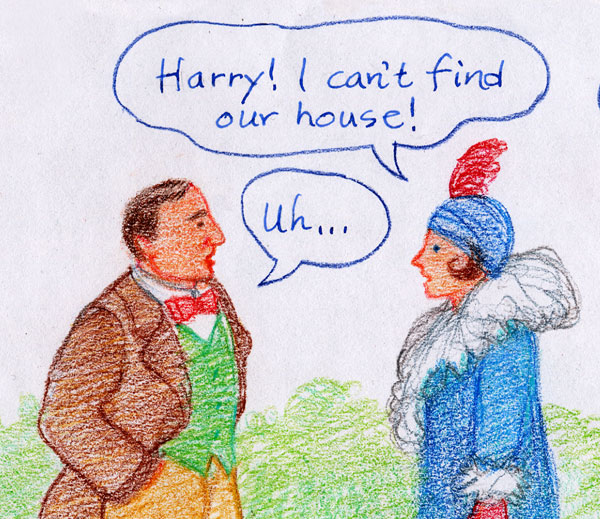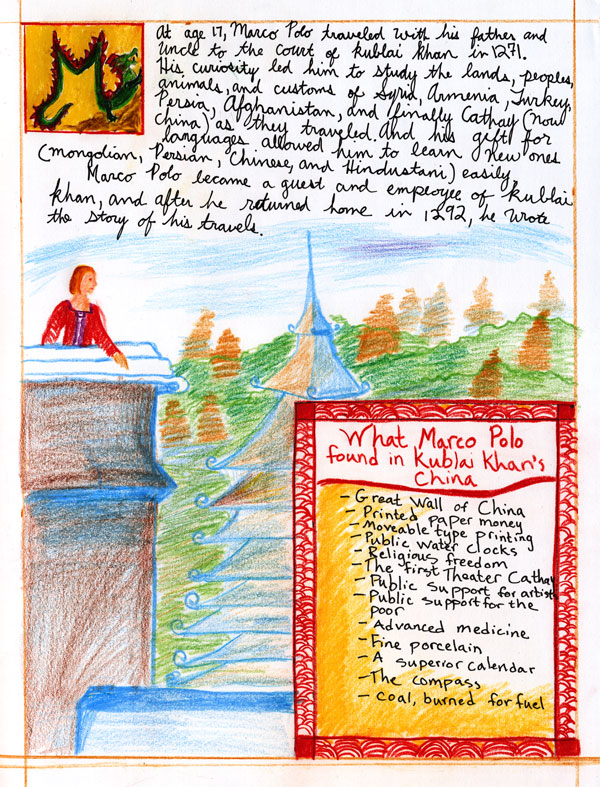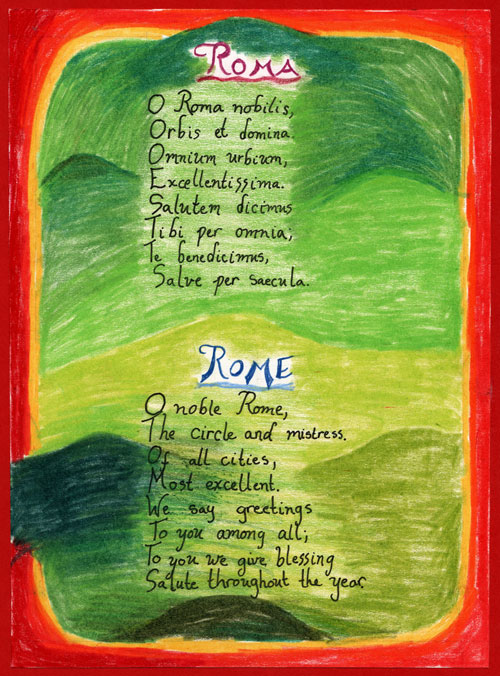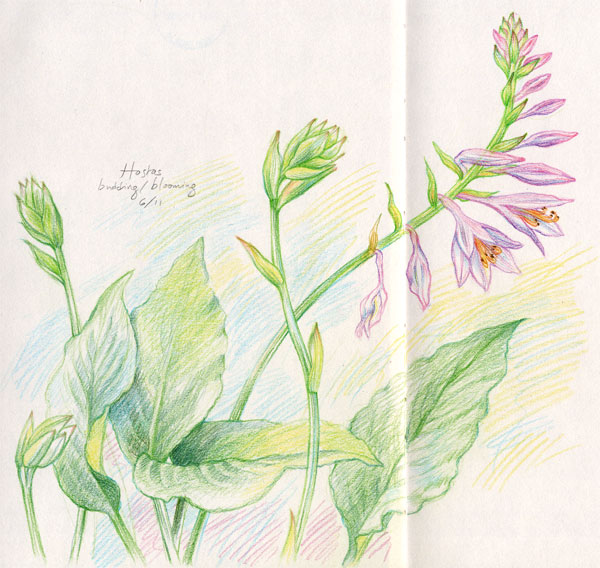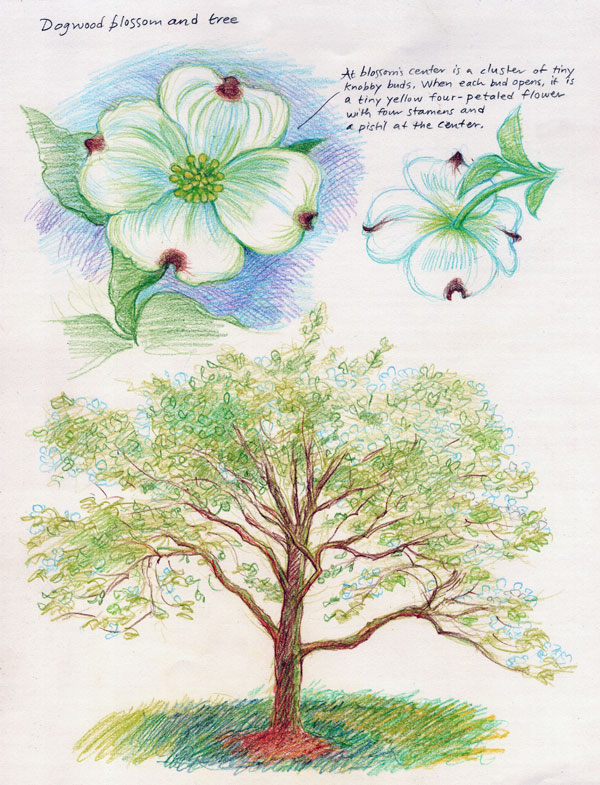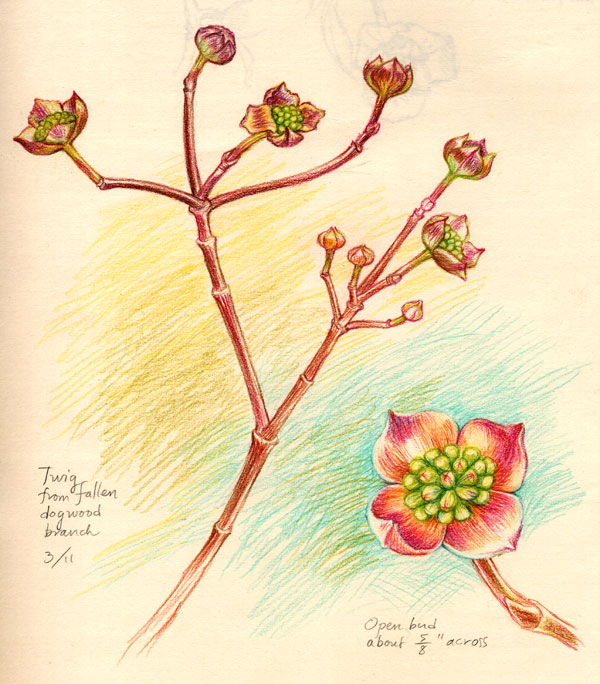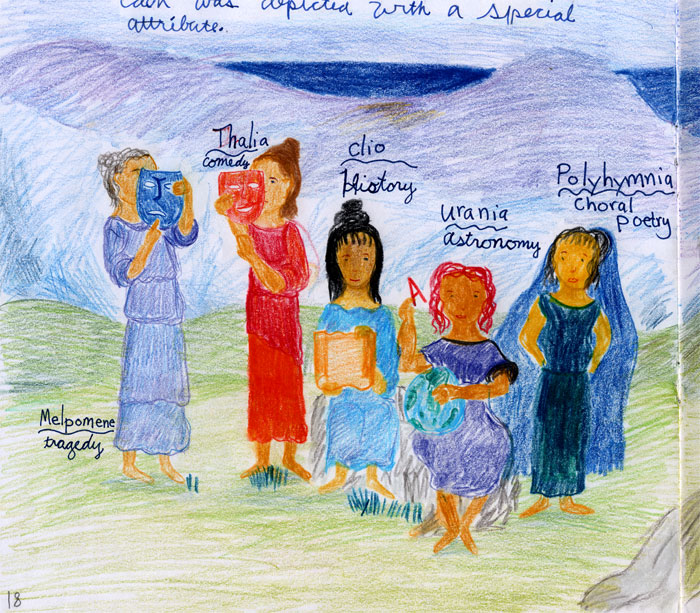Today is the birthday of Washington, DC carpenter and builder Harry Wardman (1872-1938), who is responsible for many of my neighborhood’s houses (although once he achieved success he no longer wielded the hammer personally). For a picture and bio, please see Wild About Harry.
Tag: Colored Pencil
Sisterhood of Squash
It’s finally getting too cold to draw from nature outdoors, so we’re sketching from the pantry, and thus cut open a recent discovery: a Sunshine Squash. (If you like winter squash, you will love this super-sweet and tender variety.)
It was my daughter who noticed the squash’s interior division into thirds, and, more subtly, sixths, and who suggested we add our squash drawings to our cucumber drawing pages. So we did. It’s exciting to find, despite their apparent exterior differences, their interior commonalities. And together they make a lovely pair. There’s a life lesson for you.
A Stately Pleasure Dome
If the word “Xanadu” happens to come up at our dinner table (and doesn’t it come up from time to time at yours?) we can count on our son’s launching into Coleridge’s “Kubla Khan,” which he memorized at some point due to sheer fascination with the language.
Today is the birthday of Samuel Taylor Coleridge (1772-1834), and in his honor I post the opening lines of that poem. Along with it I post my daughter’s drawing, from our homeschooling Middle Ages block, of the rooftops of Xanadu, the summer residence of Kublai Khan (grandson of Genghis Khan), who ruled China during the years of Marco Polo’s visit and subsequent years of service to the Khan.
Cambalu, the winter capital, grew quite hot in summer, so Kublai had a northern marshy river valley drained and transformed into a vast park of gardens, teahouses, terraces, and winding waterways for pleasure boats and wild birds. (Here is Marco surveying the scene from a rooftop.) At its center was the palace of polished bamboo painted with vermilion and gold and elaborate murals.
Xanadu was destroyed in the 14th century, but Marco Polo’s descriptions were familiar and inspirational to later writers, one of whose works (Samuel Purchas’ 1613 Purchas His Pilgrimage) Coleridge had been reading one summer day in 1797 before falling into a deep, some say drug-induced, sleep. While he slept, Coleridge “dreamed” the poem as a series of vivid and haunting images and phrases, which he instantly wrote down upon awakening.
In Xanadu did Kubla Khan A stately pleasure-dome decree: Where Alph, the sacred river, ran Through caverns measureless to man Down to a sunless sea. So twice five miles of fertile ground With walls and towers were girdled round; And there were gardens bright with sinuous rills, Where blossomed many an incense-bearing tree; And here were forests ancient as the hills, Enfolding sunny spots of greenery…For the rest, please see Poetry Out Loud. You will want to memorize it, too.
For another Coleridge poem, and a painting, please see Thou shalt wander like a breeze.
O Roma Nobilis
According to tradition and Edward Gibbon, September 4th, 476 is the date fixed for the fall of the Western Roman Empire. (The longevous Eastern Roman Empire had mostly been ruled separately since Diocletian’s reign, 284-305, and would hang on by its fingernails until the conquest of Constantinople by the Ottoman Turks in 1453).
In reality the fall of the Empire was more of a gradual deterioration over time, like arthritis, or a growing tendency to misplace the car keys. It took hundreds of years of bad decisions, bad luck, and bad weather for the glories of Roman engineering and culture to crumble into temporary but lengthy obscurity. But September 4th was the day on which the Germanic chieftain Odovacar and his followers bashed their way into Rome and removed the lad Romulus Augustulus from his throne, sending him into early retirement. Officially, and poetically, Rome began and ended with a Romulus.
On this day of remembrance, I post a verse from my daughter’s Ancient Rome main lesson book, which we included in morning exercises while covering that block. Composed in the 9th or 10th century by an unknown author, it was supposedly sung by pilgrims trudging toward Rome. Perhaps pilgrims of the 25th century will chant a verse in the dead language of English as they make their way to New York or Washington DC.
Hostas
Every spring these hostas miraculously emerge through a shady patch of bare earth beside the front walk: first small pale green points, then unfolding leaves, a spray of buds, and finally the blossoms. Now whenever I depart or return I am treated to a whiff of their rich heavy scent.
Dogwood Season
The cherry blossoms are succeeded now by the dogwood—not a very poetic name for so lovely and graceful a tree. Around here we see a lot of the native Cornus Florida, the state tree of Virginia. (This sketch is from our apparently never-ending homeschooling Botany block. And a marvelous excuse it is for going outside on a spring day to draw instead of practicing decimal fractions…)
For guidance in planting native trees, plus the encouraging possibility of coupons and rebates, don’t forget to check out Casey Trees and, if you are a Maryland resident, the Leaves for Neighborhoods program.
Today is also the anniversary of Maryland’s ratification of the Constitution. For a mini-history with sketches, please see Maryland, My Maryland.
This image is available as a high-resolution print on 8.5″ x 11″ archival paper.
Glimpse of Spring
A few weeks ago a fierce thunderstorm blasted our area. The following morning the neighborhood was strewn with dozens of enormous broken branches—all in bud. A little sadly, we brought home a few sprays and put them in water, the vases of bare twigs giving our table a poignant wintery appearance.
The buds, unaware of their fallen state, are now confidently unfolding and bringing forth their hidden treasures, but in miniature. This one is from a pink dogwood tree. The four bracts that usually unfold to a 2″ or 3″ diameter are here only about 5/8” across. But still beautiful.
Today is the birthday of Shakespeare and Company founder Sylvia Beach. For a sketch and a mini-bio, please see Paris Memory.
AMusement for All
On this day in 1773 a committee of the Charlestown (South Carolina) Library Society established the first public museum in the United States. Except that there wasn’t yet a United States. South Carolina was still a British colony, and the Charlestown Library Society’s inspiration for its project was the British Museum, the world’s first national public museum, founded in 1753. But by the time the doors of the new museum opened to the public in 1824, South Carolina was, and has mostly remained, part of the U.S.A. To this day you can visit and admire its displays of local natural history specimens, which the [now] Charleston Museum has continued to acquire over the centuries, along with South Carolina memorabilia.
Collecting is undoubtedly a natural human impulse, ever since our hairy ancestors stored up grain for the winter. Once basic necessities were taken care of, human beings with leisure time and/or disposable income continued for millennia to assemble various collections, from seashells to sapphires, but they were primarily for private enjoyment, profit, or study. Royalty and the well-to-do collected, and even commissioned, statuary, paintings, and elaborate furnishings for their palaces. Scholars created and collected manuscripts to share with other scholars. Scientists and amateurs alike collected unusual plants, animals, fossils, and other natural specimens, increasingly so from the 18th century onward as human beings questioned assumptions about the origins of life, the earth and the universe.
But what we now call a Museum did not exist until rather recently. The word comes from the Mouseion at Alexandria, Egypt, which was not a collection of objects for perusal by curious passersby but rather a gathering place for scholars to share scientific and mathematical discoveries (option #2 above). If you were an educated Greek male living in the Mediterranean world in the 3rd century BC and possessed both scholarly interests and travel funds, off you went to Alexandria, which had by then replaced Athens as a cultural center. Euclid studied there. So did Archimedes. The Mouseion included the famous Library of Alexandria, which sought to collect works (or copies thereof) from all over the ancient world, and at its height boasted hundreds of thousands of papyrus scrolls. Eratosthenes served as one of its librarians.
The name Mouseion indicated an institution dedicated to the Muses, who are the nine daughters of Mnemosyne, goddess of memory. Each daughter embodies a different pursuit—Lyric Poetry, Tragedy, History, etc.—and is responsible for its nurture and inspiration. These are offspring to brag about at any parent gathering. “So, what are your daughters up to these days?” “Oh, they’re the Muses of Choral Poetry… Dance… Astronomy… .” References to the Muses abound in painting and literature, from Raphael to Moreau, Homer to Shakespeare.
We honor them still when we speak of Music, or when we cross the threshold of one of the world’s thousands of Museums, which today often still serve as centers for scholarly study, but in addition are open to ordinary citizens like you and me and contain fabulous collections of every imaginable kind of art, artifact, and animal, in every possible subject—science, history, transportation, sports, toys, bananas (I kid you not)—where we can open our eyes and our minds in wonder. And even get a slice of pizza and a postcard. Thank you, oh Muses.
This is a drawing of five of them, from my daughter’s homeschooling Ancient Greece main lesson block.
In Bloom
Here is our Christmas cactus, budding and blooming in the midst of winter, a cheerful and optimistic omen for new beginnings.
Thank you for a wonderful year, faithful and enthusiastic blog readers! I have lots of ideas and plans for 2011, although after 365 days of posting I may take a break occasionally and not post EVERY day. But I won’t miss any birthdays. And, if there are people and events that you would like to call to my attention, please feel free to speak up.
Happy New Year to everyone, and may it be a year of budding and blooming for you all.
Heavenly Light
After my husband and I had completely given up hoping for another child, along came our wonderful little late-in-life surprise, making us a foursome and our solitary first-born a grateful Big Brother. Who could guess looking at this sweetly sleeping 6-day old babe that she would unfold into our exuberant, passionate, imaginative, joyful twelve-year-old who sings, leaps and dances through life, and who continues to bring wonder and surprise into every single day. Happy Birthday, dear Eileen! We are so glad you danced down the rainbow bridge to us.

